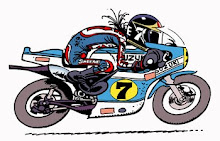 The last complete RG500 made by the Suzuki factory the 1984 alloy framed RGB500 MK9
The last complete RG500 made by the Suzuki factory the 1984 alloy framed RGB500 MK9
1982 witnessed the introduction of a significantly revised version of
the RG500 featuring a stepped cylinder, square four two stroke engine
with two crankshafts rather than the four previously employed. Typed the
MK7, the new machine was reputed to deliver approximately 115bhp. It
was followed by the MK8 for the following season which, apart from
some minor cosmetic changes was essentially the same as the MK7
retaining the power plant and steel chassis of its predecessor. 1984
marked the introduction of the final complete RG in the form of the MK9. The new model benefited from an increase in the size of the
carburettors to 38mm from the 36mm previously employed, however, it was
the chassis that received the greatest changes. The steel frame of the
previous models gave way to an aluminum box section unit that had
benefited from Suzuki's experience with the works machines. A 16 inch
front wheel was complimented by an 18 inch rear and the bodywork was
significantly revised.
For the 1985 season Suzuki adopted a new approach in respect to their
hugely successful RG500 partly in response to changes being seen in
domestic racing. National championships were moving towards production
based, four stroke formulas resulting in less demand for over the
counter Grand Prix
500's. Suzuki opted to stop
producing complete RG500's, instead supplying Padgett's of Batley with
up rated, magnesium cased, stepped RG500 engines and their associated
power valves and expansion chambers. Padgett's would then supply
complete machines using a steel frame built by Harris Performance and
based on the Suzuki Mk7/8 frame. A total
of twelve engines were supplied to the Yorkshire based company with
machines being built between 1985 and 1988, the MK type range went on from MK10 to MK14. One of the last bikes an MK14 was ridden by Darren Dixon, a Padgett's sponsored rider to victory in the 1988 British F1 Championship.
Not only Harris made frames for the RGB500 engine also Spondon, VRP and Nico Bakker did, they even made Delta Box frames in the last years.
For more pics see
Suzuki RGB500
 The Suter is ready for the 2016 TT Isle of Man, the first year will be a learning curve. Take notice of one of the pics in the link below, "4 strokes are 4 grandmothers"!
The Suter is ready for the 2016 TT Isle of Man, the first year will be a learning curve. Take notice of one of the pics in the link below, "4 strokes are 4 grandmothers"! The Suter is ready for the 2016 TT Isle of Man, the first year will be a learning curve. Take notice of one of the pics in the link below, "4 strokes are 4 grandmothers"!
The Suter is ready for the 2016 TT Isle of Man, the first year will be a learning curve. Take notice of one of the pics in the link below, "4 strokes are 4 grandmothers"! The last complete RG500 made by the Suzuki factory the 1984 alloy framed RGB500 MK9
The last complete RG500 made by the Suzuki factory the 1984 alloy framed RGB500 MK9